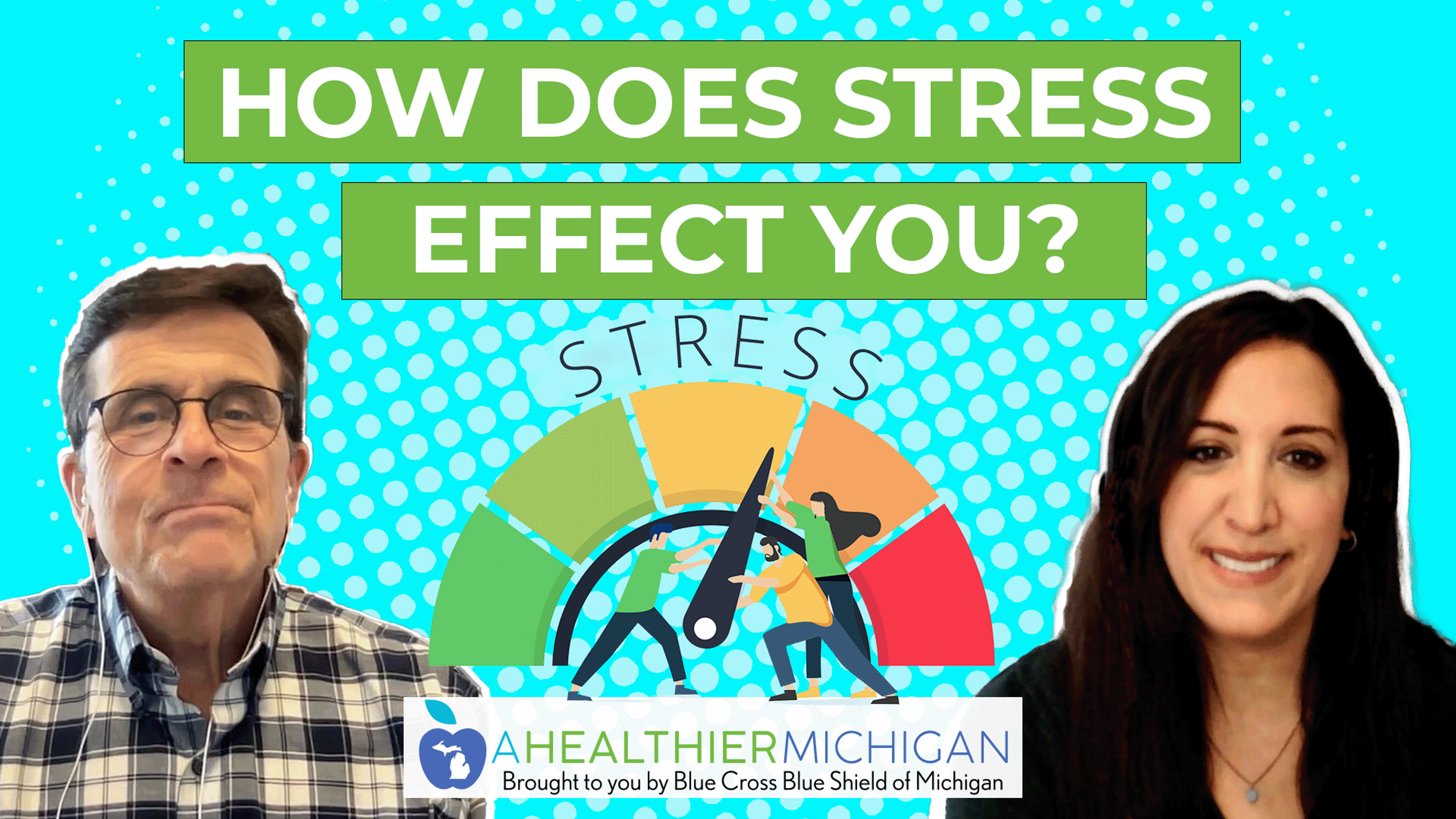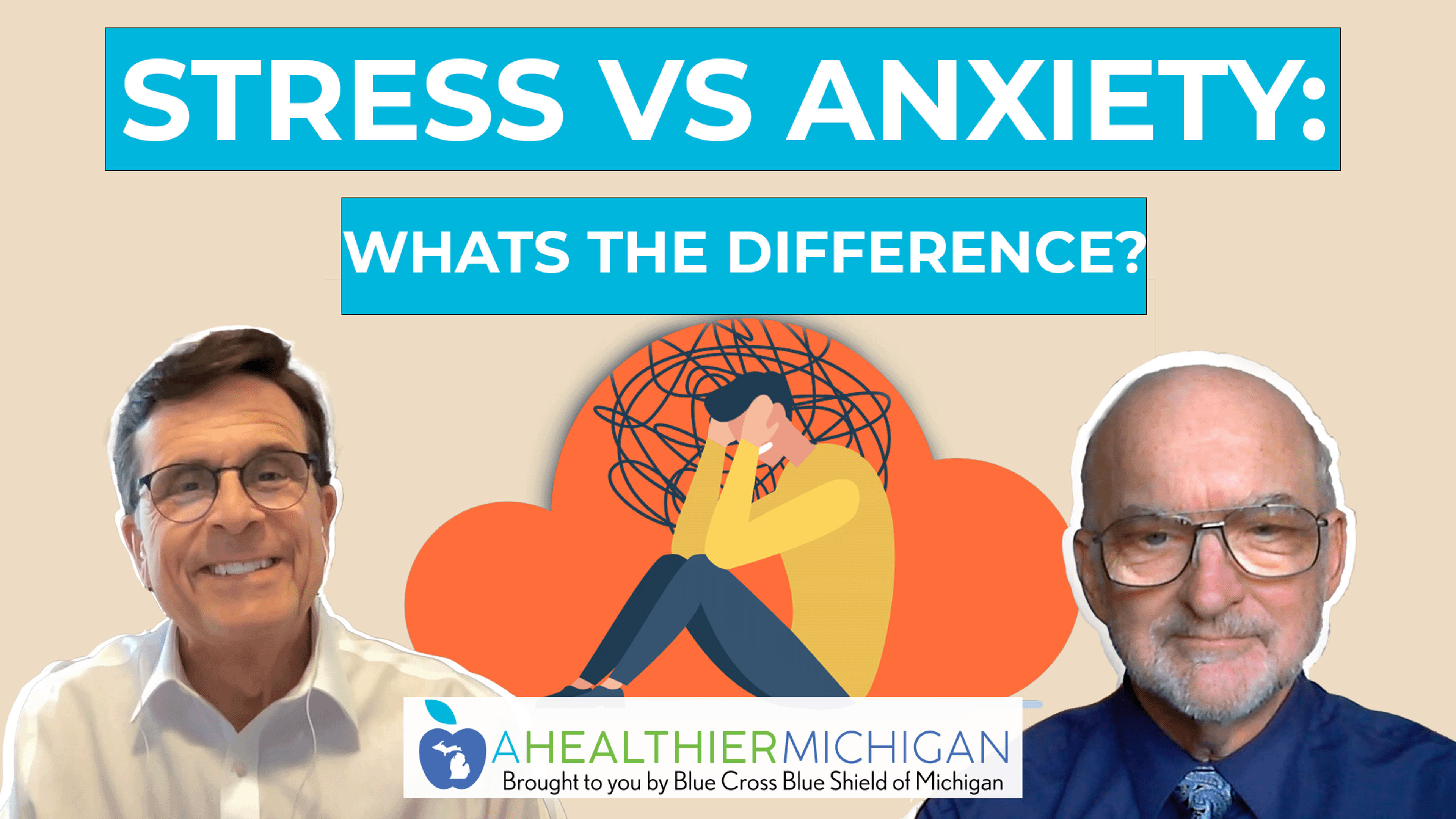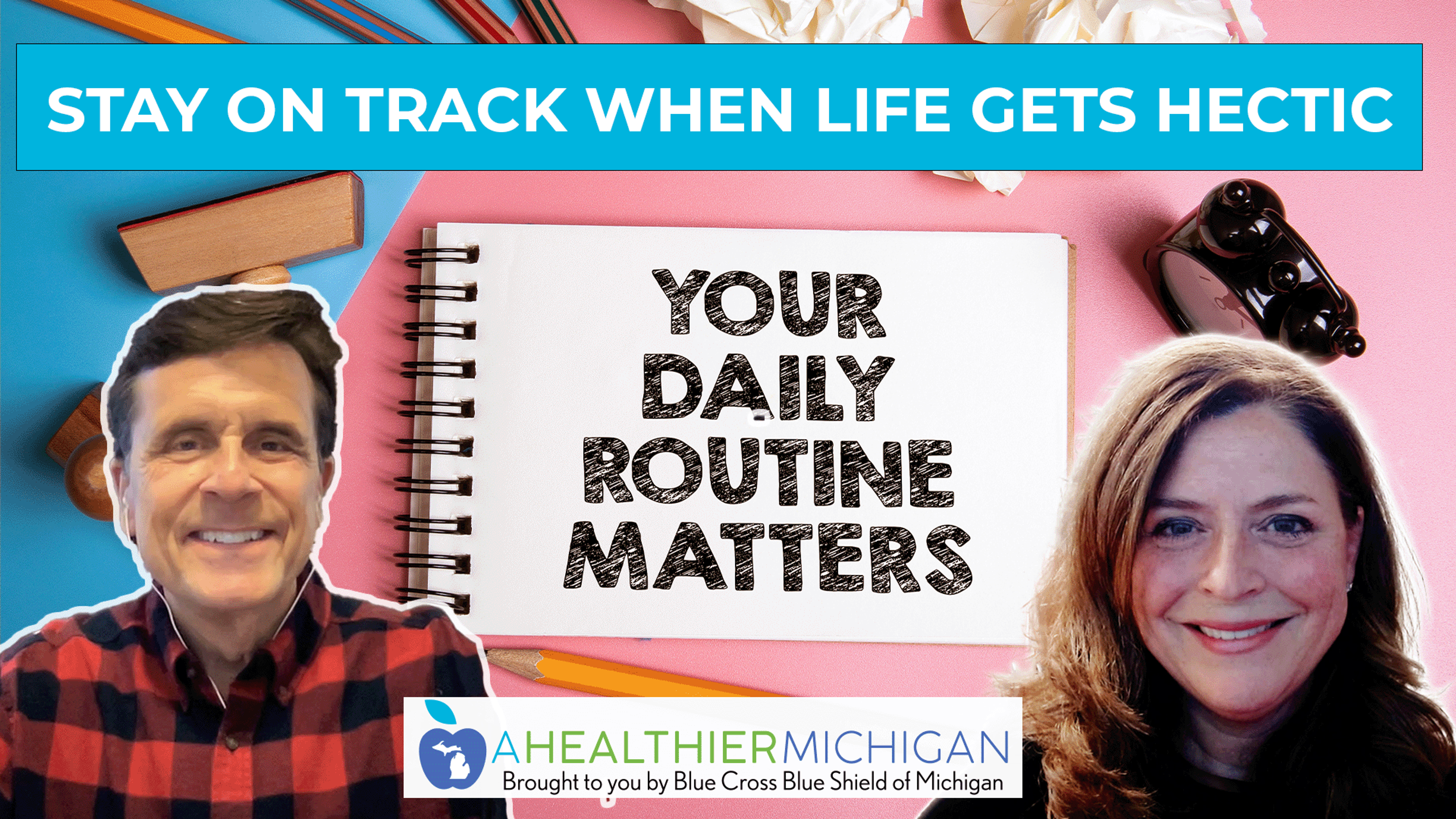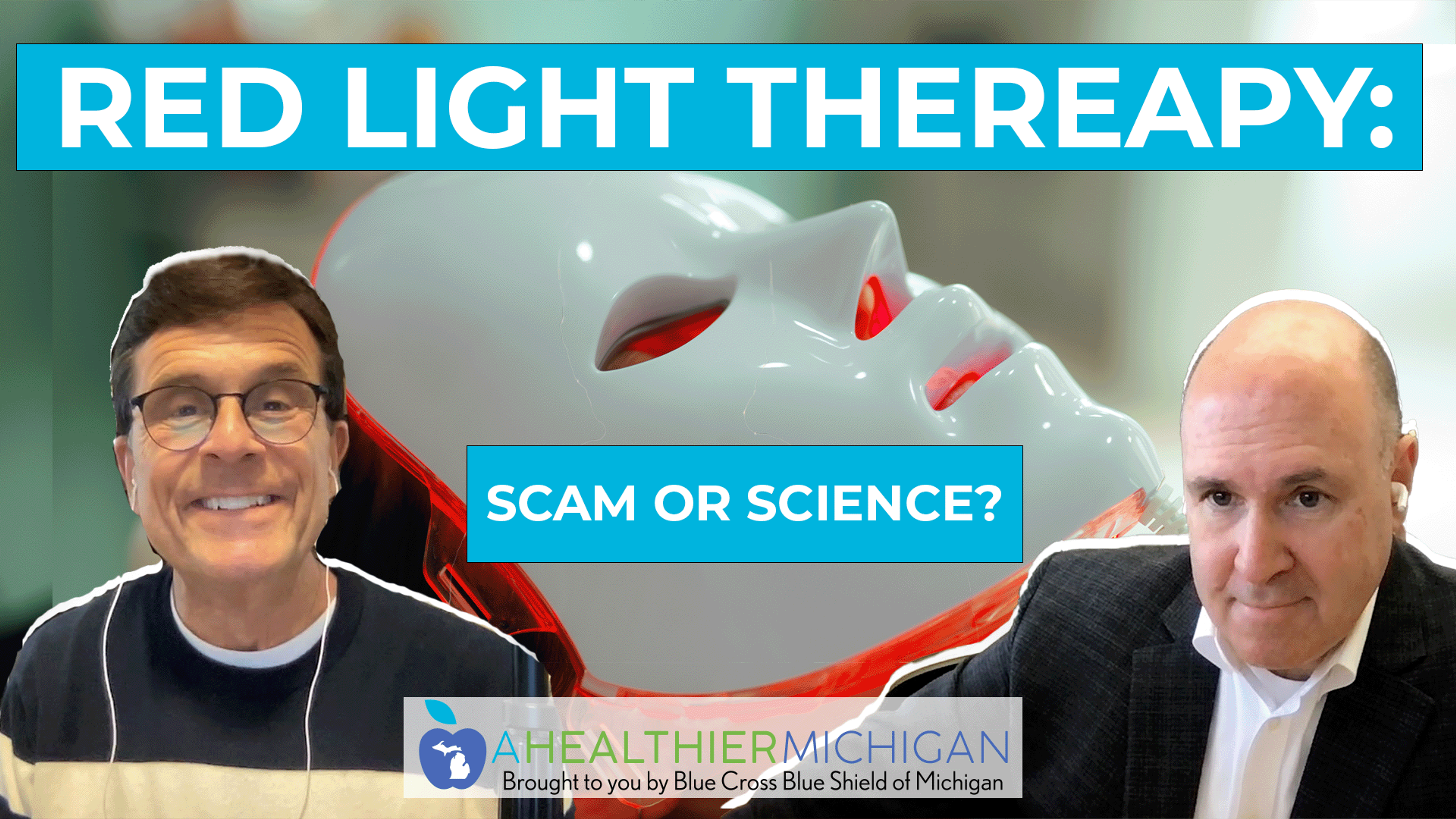How to Test for Common Food Allergies
| 1 min read

00:00
00:00
About the Show
On this episode, Chuck Gaidica is joined by returning guests: Grace Derocha and Susan Okonkowski. Derocha is a certified diabetes educator and health coach, while Okonkowski is a health manager at Blue Cross Blue Shield of Michigan. Both are registered dietitians eager to discuss the importance of testing for food allergies.
“Peanuts is our number one. It’s the number one allergen out there. It’s really common, and why it’s such a concern is, it causes such an anaphylactic, they call it, response, that if someone does have a really strong peanut allergy, and they do not get appropriate care right away … I mean, it can cause death.” – Susan Okonkowski
In this episode of A Healthier Michigan Podcast, we explore:
- The biggest food allergens on the market
- The best way to get tested for a food allergy
- The importance of a professional medical diagnosis
- The impact of heredity on allergies
- Having a food allergy vs food intolerance
- Protocol for introducing new foods to babies
Transcript
Here is the full transcript of this episode. You can listen to the audio version on streaming platforms or watch on YouTube.
Chuck: This is A Healthier Michigan Podcast, Episode 24. Coming up, we discuss food allergies and ways we can eat healthy with them.
Chuck: Welcome to A Healthier Michigan Podcast. This is a podcast dedicated to navigating how we can all improve our health and our well-being through small healthy habits we can start implementing right now.
Chuck: Let me be the first to welcome you to the first day of spring. Oh, I’m so excited. This is so great.
Grace: Yay.
Susan: Yay!
Chuck: And it’s national nutrition month, just by-the-by. I’m your host, Chuck Gaidica. Every other week, we’re going to sit down with a certified health expert … today we have two of them, from Blue Cross Blue Shield of Michigan … do a deep-dive into topics covering nutrition and fitness, and today, actually a whole lot more. On this episode, we are talking about food allergies. Perfect segue into this idea that it’s National Nutrition Month.
Chuck: Grace Derocha is back with us. She’s a Registered Dietitian, Certified Diabetes Educator, Certified Health Coach. Man, has she been coaching me. I’m not sure if it’s working. She, too, is with Blue Cross Blue Shield of Michigan. She’s a food lover. She’s a mom. Two kids, husband, which is harder to take care of? Kids or husband?
Grace: Husband, for sure.
Chuck: Husband? Okay.
Chuck: Susan Okonkowski is here. A Registered Dietitian, as well. Right?
Susan: Yeah.
Chuck: Health Manager at Blue Cross Blue Shield of Michigan, with 15 years experience working with health and well-being. It’s good to see both of you again.
Susan: Good to see you, too.
Chuck: How do I know, short of being a Google doctor, that when I eat that thing, and I get little bumps in my mouth … Is that really a food allergy? Or is it just my head telling me that I’m being a Google doctor, and I think I’ve got beriberi, or some kind of strange disease now? Because, yeah, isn’t that dangerous?
Grace: Don’t Google doctor.
Chuck: No?
Grace: That would be the first part of it.
Chuck: Ever?
Grace: Ever.
Susan: Or WebMD Symptom Tracker. Don’t want to go down that road.
Chuck: Well, I mean, okay, how do you really know? Where are these allergies coming from? There are some usual suspects, but who wants to go first? Where are they coming from? Let’s start there. What kind of foods?
Susan: Common foods, when we look at food allergies … Typically cow’s milk, peanuts, tree nuts, shellfish, fish. Wheat is another really big one, and soy. Those are your most common food allergies that are going to be out there.
Chuck: How do you really know that you have one? Outside of what’s obvious, is you’ve broken out in hives, but what if you ate three of the four of those things?
Grace: Right. Great question. You need to talk to your doctor, your allergist, and really run some tests. Run some tests before you start eliminating anything from your diets, because it might be confusing for the body to know what we’re looking for.
Chuck: I eat soy, or I eat shellfish … What’s actually physically happening in my body? That’s triggering whatever’s … I’m flushed, or I’m getting hives. What’s happening?
Susan: You’re having an immune response. Your body is reacting to that allergen, if it is an allergen. In which case you definitely do want to start documenting symptoms. That’s another big piece of identifying is this something that really is a food allergy? Or is it mixed with some other piece of clothing that got some strange-
Chuck: Oh, interesting.
Susan: You brushed off some detergent, and now all of a sudden, I’m having a reaction to that, versus the food that I actually ate.
Chuck: Mm-hmm (affirmative).
Susan: Keeping a diary of your symptoms and what you’re consuming when those symptoms are happening is going to be really helpful when you go in to see that allergist.
Grace: I think, too, that there could be little things that are happening that you might not even realize. I feel like sometimes in kids, they might be getting a little eczema, but you think, “Oh, we just came out of winter, and we’re in spring, so maybe it’s just dry skin.” A child isn’t able to explain to you, “I’ve had this patch of skin for a long time, Mom.”
Chuck: Mm-hmm (affirmative). Mm-hmm (affirmative).
Grace: “And I think it might be because of whatever.”
Chuck: In that list of culprits, are there some that jump right to the top?
Susan: Peanuts is our number one. It’s the number one allergen out there. It’s really common, and why it’s such a concern is, it causes such an anaphylactic, they call it, response, that if someone does have a really strong peanut allergy, and they do not get appropriate care right away … I mean, it can cause death. It’s very, very scary for people who have peanut allergies. Then, of course, cow’s milk is another one that really jumps to the top as far as our culprits for allergens.
Grace: I think what’s tricky when we’re talking about cow’s milk is that a lot of times when a child is born, they might have some allergic reaction to cow’s milk, but then around two or three, at toddler age, they might be okay.
Grace: It’s just that when they were that young, they weren’t ready for cow’s milk. Their body wasn’t ready to accept it. There is definitely a clear difference between a cow’s milk allergy, or a dairy allergy, and lactose intolerance.
Chuck: What would that be?
Grace: Usually, when you have a food allergy, you’re allergic to the protein in the food. But lactose is the dairy sugar. I’m lactose intolerant, and I have side effects that are not anaphylactic, that aren’t deadly. I might have a stomach ache.
Chuck: Yeah. Everything is milk now. I mean, it seems like you can run hot water over almonds, and call it almond milk. Should we be making switches like that? Because aren’t we also at risk of missing out on the vitamins and other things in the cow’s milk, if we’re not careful?
Susan: That’s why it’s really important to really get tested and ensure that you do have an allergy, before you just start replacing, like, “Oh, I heard oat milk was the new best thing, and I’m just going to start drinking oat milk.” Because you might actually be missing out on some of the appropriate nutrients that you do need, if you don’t have that cow’s milk.
Chuck: Can I just say, I didn’t even know there was oat milk? I drink soy milk every day, and it seems to work fine. But it’s got protein, and it seems to have more stuff than some of the others. You’re telling me there’s … What are they doing? Grinding up oatmeal and putting water with it?
Grace: Essentially.
Susan: Yes.
Chuck: Come on!
Grace: Yes.
Susan: Yeah.
Chuck: For you, as dietitians, how do you look at that kind of product? Not just that one specifically, but … It just seems like watery oatmeal to me.
Grace: Yeah, so I think it’s tricky. Yeah. Pretty much. I think it’s tricky, because cow’s milk gives us a lot of different things, and one of those things that is missing in a lot of milk substitutes is protein.
Chuck: Mm-hmm (affirmative).
Grace: Soy has some.
Chuck: Yeah.
Grace: Golden pea milk has some. I’m trying to think if there’s any other ones. That’s pretty much it.
Susan: Yeah.
Grace: Your almond, your cashew, your coconut milk-
Chuck: Yeah.
Grace: I’m not talking about Thai coconut milk in the can. I’m talking about.
Chuck: Yeah. No, I’ve looked at all the packaging, and I find it fascinating that all this stuff is happening right before our eyes. As a matter of fact, if I’m not mistaken, maybe it was a month or two ago the Dairy Farmers of America have asked Congress to now pass a law that says cow’s milk has to have a definition, from lactating cows that are healthy, because milk is sort of like saying, “I’d like a Coca-Cola. I’d like a Coke.” Well, that’s any drink.
Susan: Yes.
Chuck: Right?
Grace: Your right. Right.
Chuck: I think they’re trying to rein this in, because they’re seeing that this is influencing their business.
Grace: Right.
Chuck: Yeah.
Chuck: Allergies can give us all kinds of fits. It can be intestinal stuff. It can be something that breaks out in our skin. How do you get tested? I remember, back when I was a kid, I had a test where they poked some needles in my arm for something, and I was fine. I’m assuming we’ve gone light-years beyond there, or have we?
Susan: You still can do that skin testing, where they’ll do the whole RAST chart on your back, and test different allergens-
Chuck: What’s that mean?
Susan: They test for all kinds of different allergens, and they’ll do a little poke in the skin, with-
Susan: Actually, I went through this with-
Grace: Scratch.
Chuck: Maybe that’s what I had.
Grace: Yeah.
Chuck: Yeah.
Susan: Yeah, a scratch test.
Chuck: Okay.
Susan: There’s also blood tests. They can detect a lot from a blood test, when it comes to allergens. Then there are those more invasive tests, when they’re looking for a wheat allergen, they can do a lot of GI testing.
Susan: It just depends upon what allergen they’re looking for, too, and what levels they’re finding. If the blood is like, “Oh, we kind of see something,” then they’ll go and do further, invasive testing.
Grace: I’m glad that you brought that up, Susan, because like we were talking about earlier, if someone starts cutting out, for example wheat or gluten, already, and then they’re trying to get tested to see if they have an allergy, and they have a more invasive … It will be inconclusive. We won’t know, because it’s not in the system anymore to be able to see if there is that effect on the body.
Chuck: Outside of having friends who may say something to you. “Hey, it’s bad to do this,” or “Don’t drink soy milk,” or “Don’t do … ” We were talking about this off-mic. There are nationally recognized, internationally recognized influencers who are getting off of certain foods … Should we call her out? Gwyneth Paltrow? Huh? I don’t know her. She doesn’t call me anymore.
Chuck: But I mean, really. You can get influenced by so many different inputs. “Don’t do this anymore. Oh, a new study came out, and it made it on CNN.” All of a sudden, you just think, “I can’t do anything. I mean, I can’t eat. I can’t drink.”
Grace: I know. Don’t think about that.
Chuck: No?
Grace: Whatever that was.
Chuck: Yeah.
Grace: Because you’re going to be in … No, so I think it’s tricky, because there is so many outside influences. People can Google a million things. People heard so-and-so said, “If you have celery juice and not celery, it’s going to make your skin perfect, and you’re going to lose 25 pounds in three seconds.”
Grace: You hear all these things, and I think that’s one of the tricky things with food in general, is that people want instant results. Because everyone eats, and there has to be a solution, right?
Chuck: I know this is got to be maddening for somebody who really deals with this, because okay, you block those outside influences, and then you do get to the point where you’ve got to go to your doctor.
Chuck: I think it’s helpful that maybe, and we’ve talked about this in other episodes, that we’re somehow tracking the things … We can actually bring a little piece of paper, even a cheat sheet, and say, “Doc, every time I’ve done this, this happens.”
Grace: Mm-hmm (affirmative). Yeah.
Chuck: Right? Would that be good to know?
Grace: Yeah, being observant. We’ve talked about … Being observant about your own body, and how you’re feeling, and what’s going on. Then, if it’s persistent.
Chuck: Mm-hmm (affirmative).
Grace: Being able to have that open and candid conversation with your doctor, or your allergist, or whoever it might be, to try to explain that to them.
Chuck: If I’m allergic to wheat, is it important for me to know that either my mom, or a grandmother, was. In other words, does family history influence this? Or the DNA of an individual is just so different, it doesn’t matter?
Susan: Sometimes it can.
Chuck: Yeah?
Susan: But it’s not always a surefire thing that, “Oh, Mom had a dairy allergy. Mom had a cow’s milk allergy. Mom had a wheat allergy,” that I’m going to have it, too. It’s an important piece for an allergist to look at, to say, “Okay, this is part of everything that we’re looking at, in scope of this one individual and what they’re experiencing.” But not a surefire thing that Mom had cow’s milk allergies, so is the child.
Chuck: Yeah.
Grace: Yeah, and I think it’s important, too, on the topic of wheat and gluten, that there is wheat and gluten allergies, and sensitivities, but then there’s also something called … and I know you guys know … celiac disease, which is actually an autoimmune disease that your body rejects gluten.
Chuck: Our son developed that.
Grace: Mm-hmm (affirmative).
Chuck: Yeah, so I mean, it’s a real serious thing. Then, you get to this level of being protective within your own space that you can control. At Thanksgiving, in the foods you buy, you know what you’re looking for.
Chuck: But now you go out to eat. I mean, you’re talking about the world is your oyster. It is, but how do you know what little splash of hot sauce, or the wheat that thickens up the gravy. You know what I mean? It’s got to be so tough.
Susan: It’s really difficult. I mean, I myself have a gluten intolerance, and then I have a child who had a milk allergy. Now, she has outgrown it, as we talked before, like so commonly, by age three, she outgrew it.
Susan: But one of the first things we always do, and I tell everyone, if you have allergies in your family, when you go out to eat, tell that waitstaff the minute you sit down, “I have a severe allergy to X.” Whatever that food is. So they know, and they can help service you, as best as possible.
Susan: Because I feel like a lot of restaurants out there now are doing so much of a better job at catering to all the different food allergies. When they know, they can be right there to help you.
Chuck: Yeah.
Grace: I’m glad you brought that up, because I think there has been a lot of progress. I remember … whoa. I almost said how long I’ve been a dietitian.
Chuck: Yeah, like you’re really an old person. Stop.
Grace: Like 20 years.
Chuck: Yeah.
Grace: But early on, when I was a dietitian, my patients had to order their food. Like online.
Chuck: Oh, yeah. Yeah.
Susan: Yep.
Grace: They had to order it, because it wasn’t really in stores. They could never go out to eat.
Chuck: Yeah, what did we do before online?
Grace: I know.
Chuck: I mean, and that wasn’t that long ago. Because what choices did you have-
Grace: Mail order. Yeah.
Chuck: Yeah.
Susan: Yeah, the special bakery in New York, years and years and years ago … I just remembered. There was this one bakery that specialized in making bread that did not have gluten. People would order it from that one bakery, because they knew about it. It was crazy.
Chuck: Well, because of our son’s gluten intolerance, celiac, you go stand in line at the one place in Plymouth-Canton-Northville that sells fresh bread for any occasion, especially holidays? There are lines out the door. It looks like the Honey Baked Ham store some days.
Grace: Yeah. I had patients who have some people in the family with celiac, or a wheat allergy, and they would have two different bread-makers. One for the people in the family that could have it, and then for everyone else that couldn’t, they had two different bread-makers and would make it themselves.
Chuck: I want to double back to something, because when I had that scratch test, I said my arm … It must have been on my shoulder, as I’m recalling. Right on the back here? I flunked. Meaning … or I passed. I had no problem. It was just in my imagination, whatever that issue was, and I don’t even remember.
Chuck: But you talked about, a minute ago, Grace, this idea … Don’t just start eliminating things, because you haven’t gone to the doctor yet for a baseline.
Grace: Right.
Chuck: Right? I mean, they have no way to start to assess. Is it important that we don’t go on what I’ve heard people have to do, the elimination diet, to get rid of things? Go see the doctor. That’s the starting point?
Grace: Yeah. But to piggyback off of what Susan said. If you are having an anaphylactic reaction-
Chuck: Oh, yeah. Yeah.
Grace: … where your throat is closing. I just want to make sure. People out there, if your throat is closing, eliminate that.
Chuck: Is that the EpiPen? Is that what you’re looking for in that case, if you happen to be near somebody?
Grace: Yes. Everyone that has an allergy should carry an EpiPen to avoid anything terrible happening.
Chuck: Yeah. Yeah. Okay. But going to see the doctor, if this is something that’s recurring, that is the first step, right?
Grace: Yes.
Chuck: Don’t just start throwing things out the window in your diet, because you don’t know.
Grace: No. Don’t Google doctor that one. We can’t forget about any new parents out there. I feel like, even as a dietitian mom, and I’m sure Susan can agree with this, trying to figure out how to navigate introducing new foods … One thing I want to make sure that we say, is when you are introducing new foods to your baby, that you do it and give it some time before introducing another new food. Usually, three to five days of just one new food at a time, so you can see if your child has a reaction.
Chuck: Mm-hmm (affirmative).
Susan: Exactly.
Chuck: At how many months away … or not quite a year for you, right? Since you had a child?
Susan: Yeah. He’s six-and-a-half months old right now. Actually, it’s funny, we are just starting that process, because I started him on a little bit of sweet potatoes when he was five-and-a-half months old. Doing that same progression.
Susan: It is … You have to be careful, because there’s some mixed foods out there, like sweet potatoes and corn. Which is fine to give them once they’re a little bit older, and you know that they don’t have a reaction to either one of those foods. The other thing, too, is just to make sure you do wait until at least four months, and then talk with the pediatrician, because sometimes they do want you to wait until six months.
Chuck: How much time are you saying between one food and another? I’ve introduced sweet potatoes. I should wait weeks? Two weeks? I should wait what?
Susan: Three to five days.
Chuck: Oh, that’s it?
Susan: Mm-hmm (affirmative).
Grace: Yes.
Susan: Yep.
Chuck: Okay.
Grace: Those reactions, I think we’ve touched on them a little bit, but could be even a little eczema, or a rash around the mouth, is what you’d usually see first in a baby.
Chuck: Because you know, we dads, we just want to start them on steak. We don’t care. “Here’s a potato and a steak. Let’s go.” I mean, we’re not-
Grace: Game on! We’re grilling now!
Chuck: I shouldn’t say “we.” I’m throwing all of us under the bus. I’m saying “me.” I would just go with the whole thing right away.
Grace: Well, and that is interesting to state, because my husband was like, “I have no … ”
Chuck: “I don’t know!”
Grace: “Tell me what to do.”
Chuck: Yeah.
Grace: “What is happening?” Yeah. It’s tricky.
Susan: It is really tricky. How often do you feed them? How many meals? What’s the interval of time between milk?
Grace: Now that I’m feeding them, do we give less milk? When do we give the milk?
Chuck: Is your husband into it, Susan? Is he connected to this idea of … Or do you tell him which jar to open, and it’s all set.
Susan: He’s connected, but I typically run the show most of the time. But …
Grace: Sounds about right.
Susan: Yeah.
Chuck: Yeah, here, too, for all of our friends who are listening.
Chuck: Okay. What is National Nutrition Month? Do the two of you celebrate and put on funny hats and party favors? What is this supposed to be for?
Grace: We have to wear a fruit and vegetable hat everywhere we go during this month.
Chuck: Yeah.
Grace: Like the Chiquita banana-
Susan: I was just thinking. The Chiquita banana lady.
Grace: I feel like, I know last episode I talked about it a little bit, but it’s fun to have my dietitian friend and colleague here to talk a little bit more about your feelings on National Nutrition Month.
Susan: But it’s a focus, for National Nutrition Month, out there, to make sure that everyone understands everybody eats food. But let’s focus in on what are those healthy foods? And that there are professions out there, like dietitians, who that is our industry.
Susan: We are here to help individuals figure out the food world, and navigate what’s healthy? What’s not? It is really that focus on, there is a profession out there, there are people out there, to help you. We love what we do, and don’t just listen to that latest news story about celery juice, and, “Yes, you need to drink all this celery juice.”
Grace: Yeah, or “Pour turmeric in your hair.” Whatever.
Chuck: Well, yeah, but see, there is that stuff that you two would be in-tune to, probably more than me as the average person walking around … I see the studies that say, “Don’t eat popcorn. Don’t … ” You can’t do anything, sometimes. The good stuff can be bad, and even the bad stuff can be bad.
Grace: Yeah. Right. It is … It’s funny. A colleague, she just made some energy bites. She was very excited, and she put turmeric in them. She followed some recipe. And I was like, “Oh, why did … ” Because it was a combination was interesting, and then she had turmeric.
Grace: I was like, “Oh, why did you put turmeric in there?” She was like, “Well, it was in the recipe, and I heard it was good.” I’m going to throw out a fun fact for people. Turmeric does have anti-inflammatory properties in the curcumin in the turmeric, but you can’t actually absorb that curcumin in the turmeric if you don’t have black pepper.
Chuck: Right! That’s what I’ve heard.
Grace: Yes, so … She’s like, “I put turmeric in here to make it taste weird, and I didn’t even get the good effects.”
Chuck: Can I tell you a funny story? Somebody gifted me one of those small little … It’s not an envelope. A little packet. A mix that you drop into your coffee, with turmeric. Didn’t have black pepper. So I know what you’re talking about, that you need to have it.
Chuck: I come home. Susan is there, my wife is there, she said, “What are you doing?” I said, “I’m making a coffee.” I pushed the Keurig button. It comes out. I put in this little packet, and then I’m thinking, “Oh, wait a minute. There’s not black pepper.” I read it. No black … So I put black pepper.
Chuck: I took one swig, and forgive me ladies, I spit it right out. It was like the worst tasting … I don’t know how anybody can do that every day.
Grace: Yeah.
Chuck: Ugh!
Grace: That’s the thing, something like that becomes a buzzword, and then people are putting turmeric in everything. But basically, you’re getting good color into your coffee, and some turmeric flavor. But you’re not going to get the full benefit of what that spice has to offer you.
Chuck: Before we throw out the baby with the bathwater on some of these things, even in eliminating, we’ve got to be really careful that as we eliminate one thing, we’re not setting our bodies up for a deficiency of Vitamin D, or B, or whatever. Right?
Grace: Yes.
Chuck: I mean, if you were told you have an allergy?
Grace: Exactly.
Susan: Yeah.
Grace: Absolutely.
Chuck: Yeah?
Susan: Yeah, I mean, when you think about these common food allergies, there is oftentimes this thread. You’re going to lack protein. You’re going to lack B vitamins. You’re going to lack iron. Calcium is one of the biggest ones, too, obviously with cow’s milk, that you’re going to need to replace.
Grace: Yes. But friendly reminder to all the people, there are lots of different foods that have calcium. Dark, leafy greens, almonds … Even oranges have some, and I’m not talking about orange juice where they add it in.
Chuck: Yeah. You know what I loved about this podcast, and I’m sorry, we’re at the end of our rope here, is that even though we do have some video snippets that may appear, when you just said “all of the people out there,” you actually did that with a flourish. It was like “Aaallll of the … ” It’s a podcast. I just wanted to let you know. Grace-
Grace: Thank you for that friendly reminder.
Chuck: Nice to see you.
Grace: Great to see you, too.
Chuck: Yeah, good to see you, as well.
Susan: Good to see you. Thank you.
Chuck: Thanks for being here, and let me just tell you. I am so excited that spring has sprung. I’m not sure we’re quite done yet with getting cold air, but we’re into that season where now we can get all healthy together, listen to our podcasts, and go out for big walks, and start to get things together. Right?
Chuck: Susan and Grace have been with us. That’s been nice. This is A Healthier Michigan Podcast, brought to you by Blue Cross Blue Shield of Michigan. If you like our show, you want to know more, don’t forget we have previous episodes. This is Episode 24.
Chuck: You can check it out online: ahealthiermichigan.org/podcast. Or leave us a review or a rating on iTunes and Stitcher. You can get episodes on your smartphone or tablet, as well, so you can take us for a walk.
Chuck: There’s lots of good content. Lots of great stuff from all the experts at Blue Cross Blue Shield of Michigan on all of these previous episodes and, of course, more to come this year. You can subscribe to us on Apple Podcasts, Spotify, or your favorite podcast app.
Chuck: I’m Chuck Gaidica. Thanks for being with us. Welcome to National Nutrition Month and, also, spring.





